As mobile technology becomes more and more ubiquitous, there has been a rising trend in consumer behavior that may have (and perhaps already has had) a negative effect on sales. This trend is called "showrooming". Showrooming is when consumers take products for a sort of test run in stores before ultimately purchasing the item online from the cheapest vendor they can find; i.e. they turn brick and mortar stores into showrooms instead of shops.
To be fair, we all do it. Why wouldn't we choose the cheapest option with free two day shipping? Well, that's exactly the question you need to answer to turn showroomers into shoppers!
 Poor Borders. Bookstores in particular have taken a big hit because of Amazon.
Poor Borders. Bookstores in particular have taken a big hit because of Amazon.
Here are a few ways to try and keep customers buying from you instead of Amazon.
1. Don't shun the Internet, use it.
When customers are turning to their smartphones in your store it's for information on the products you have. Integrate your company website with your brick and mortar store by accurately showing which items are in stock and your current inventory. Let people know that the item they're looking for is in stock at your nearby store because the convenience of it being readily available might encourage people to come in. Don't have a website? Get one. It is imperative that people be able to at least find you online, but it's even better if they can purchase your products on your own site if they're already looking on the web.
2. There's an app for that.
Along with tip number one, many businesses have seen success by creating free downloadable apps for their customers. An example of a company that does this really well is Hobby Lobby. The Hobby Lobby app does offer the ability to shop their online store, but it does even more to draw customers into the store by offering weekly coupons, a store locator, and articles with inspirational home decor and craft ideas. Customers like that there is almost always a sale or offer that they don't have to print out to use. The store locator lets customers know that a brick and mortar location is closer than they might have thought.
3. Make it easy.
Some people prefer shopping online because it's so easy. Just click and ship! Great customer service and delivery programs can help make shopping in-store seem easier for the consumer who hates shopping. See if you can offer same-day shipping or home delivery programs for customers looking for an item that is out of stock. Mark everything clearly and have visible wayfinding signs to help customers quickly find what they are looking for. Point-of-purchase displays make it easy for customers to find items they might have missed and have proven to increase impulse purchasing exponentially.

4. Make sure employees know their stuff.
Never underestimate the power of good-old-fashioned human interaction. Train employees extensively in knowing your products, the layout of your store, and in being genuinely helpful. A salesperson's ability to immediately find what a customer is looking for, make knowledgeable recommendations that aren't just upselling tactics, and build rapport with the person they are helping can go miles in creating not only a one-time sale but a return customer. You may not ever be able to beat the prices of online wholesalers, but they'll never be able to provide the human connection and interaction customers can experience in your store. You should also train your sales team to recognize showrooming tactics (scanning barcodes or searching for identifying information like ISBN numbers) and respond by being as friendly and helpful as possible.
5. Create a sense of community.
Small Business Saturday isn't the only time of year you can remind customers that shopping in-store instead of online helps keep jobs in the community and improve the local economy. Loyalty programs can also help people feel connected with your company. Offer special discounts to members who shop in your store, reduced shipping, or early access to new products. Create ways for customers to interact with your company. This can mean anything from holding contests to responding to customer reviews on a company Twitter account or Facebook page. Be creative and stay true to your brand to come up with ways to delight your customers into wanting to interact and come back to your store.
6. Utilize exclusivity.
See if you can partner with the vendors of some of your products to sell exclusively in the store instead of going online. Offer in-store amenities like free gifts with purchases or in-store only discounts. Basically you want your customers to feel like it will be more worthwhile for them to shop in your store than it would be online. Another aspect of exclusivity is making things seem like they are limited. Either they will only be in stock for a limited time or there is a limited quantity for purchase. People are more likely to make an impulse purchase if they believe the offer won't be on the table for much longer.
7. Make shopping at your store an experience.
In addition to providing customers with a great customer service experience, do everything you can to make being inside your store a great experience. Know your customers and what they'll be interested in. Bass Pro Shops, for instance, will often make their stores into a sort of hunting and fishing theme park with elaborate displays with life-sized animals and plant life. Ikea stores lead people on a maze-like journey through showrooms meant to inspire them in their own home decorating. People interested in what they're selling are often willing to drive great distances to shop at these stores because they offer a great shopping experience.
Have any more tips? Leave a comment below!



Leave a Reply